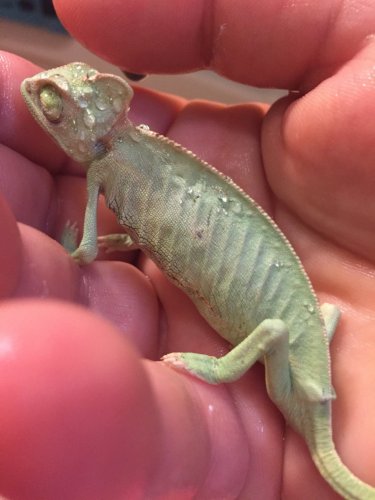Hockey&Lizards
New Member
Hello,
I just lost my baby veiled this morning due to a respiratory problem.
I am a newbie and had done a lot of research before setting up and purchasing Slappy. When she was sick I posted in the health area and it was mentioned that I had a lot of mistakes in my set up. I want to fix those so that we can eventually get another cham.
This is the setup.
I have an exo terra glass terrarium, 36x18x36. During my research it seems to be a hotly debated issue. This specific type of terrarium has venting in the front and screen on top. It is suppose to create a chimney effect. I chose the cage because we have 2 cats and a 5 year old little boy. But now I’m debating between adding a small fan to help air circulation or changing out to a Reptibreeze LED deluxe 24x24x48.
It is planted with clay balls at the bottom, screen, a mix of organic earth and coconut fiber. Sporgam moss on top and a springtail culture added. A small ficus, bromolid, and a couple small ivy plants from LlReptile.
There is a magnetic fake rock ledge with a worm cup as well.
Location: on top of a dresser in a bedroom. Near a window that the blackout curtain is drawn 99% of the time. About 4 ft off the ground and 3 ft away from the floor vent.
Watering: MistKing- 4x a day, 1min duration. Dripper over ficus.
Lighting: zoo med dual light hood with reptisun 10uvb and daylight blue 60watt. On a timer, 7:30am-7:30pm.
Temp: 70.9 at bottom (digital), 75 at top (analog), 82.1 at basking (digital). I need to get these temps up but I’m not sure how.
Humidity: currently close to 75% (analog) because I increased the mist for more humidity b/c of the respiratory issue. Usually about 55%.
Feeding was:
Crickets and dubias are the staple. Both gut loaded on Cricket Crack. Rotation different worms, butterworms, hornworms, pheonix worms. A wax worm for an occasional treat. Want to try silk worms.
Suppliments: reptivite for all 3. Multivite 1x a month. Calcium w/d 1-2 times a week, the rest of the time Calcium w/o d.
Thank you!!!
I just lost my baby veiled this morning due to a respiratory problem.
I am a newbie and had done a lot of research before setting up and purchasing Slappy. When she was sick I posted in the health area and it was mentioned that I had a lot of mistakes in my set up. I want to fix those so that we can eventually get another cham.
This is the setup.
I have an exo terra glass terrarium, 36x18x36. During my research it seems to be a hotly debated issue. This specific type of terrarium has venting in the front and screen on top. It is suppose to create a chimney effect. I chose the cage because we have 2 cats and a 5 year old little boy. But now I’m debating between adding a small fan to help air circulation or changing out to a Reptibreeze LED deluxe 24x24x48.
It is planted with clay balls at the bottom, screen, a mix of organic earth and coconut fiber. Sporgam moss on top and a springtail culture added. A small ficus, bromolid, and a couple small ivy plants from LlReptile.
There is a magnetic fake rock ledge with a worm cup as well.
Location: on top of a dresser in a bedroom. Near a window that the blackout curtain is drawn 99% of the time. About 4 ft off the ground and 3 ft away from the floor vent.
Watering: MistKing- 4x a day, 1min duration. Dripper over ficus.
Lighting: zoo med dual light hood with reptisun 10uvb and daylight blue 60watt. On a timer, 7:30am-7:30pm.
Temp: 70.9 at bottom (digital), 75 at top (analog), 82.1 at basking (digital). I need to get these temps up but I’m not sure how.
Humidity: currently close to 75% (analog) because I increased the mist for more humidity b/c of the respiratory issue. Usually about 55%.
Feeding was:
Crickets and dubias are the staple. Both gut loaded on Cricket Crack. Rotation different worms, butterworms, hornworms, pheonix worms. A wax worm for an occasional treat. Want to try silk worms.
Suppliments: reptivite for all 3. Multivite 1x a month. Calcium w/d 1-2 times a week, the rest of the time Calcium w/o d.
Thank you!!!




